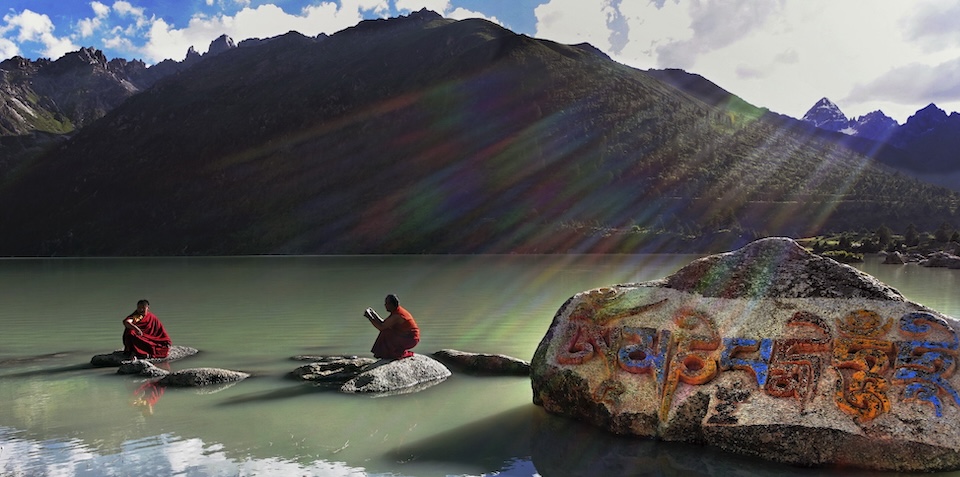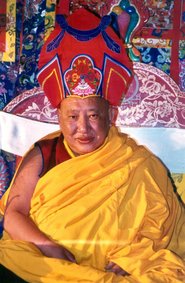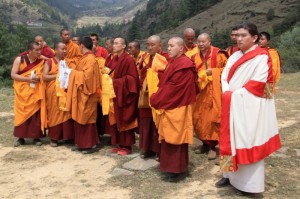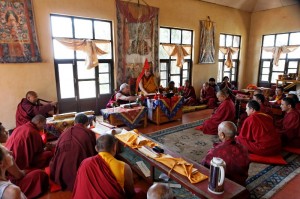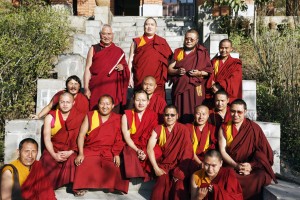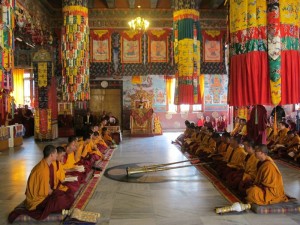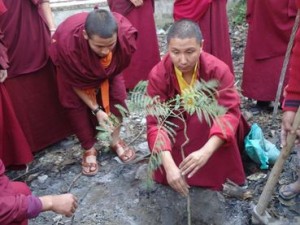#1 – July 2012 Newsletter
In this edition:
Kyabje Taklung Tsetrul Rinpoche accepts request to become supreme head of Nyingma School
News from Dilgo Khyentse Yangsi Rinpoche
News from Shechen Rabjam Rinpoche
Graduation and Exam Results
Seven Monks enter the 4th Three Year Retreat held at Shechen’s Retreat Center at Namo Buddha
Yarne Summer Rains Retreat
Shechen Ogyen Chozong (Sissinang Nunnery) News from Bhutan!
Coming Soon! Shechen online prayer requests
Meditation and the brain: Neuroscientist Maria Kozhevnikov returns to Shechen Monastery
“Buddhism and Science Exhibition” to be hosted at Shechen Monastery in November
Khenpo Karma Tsultrim and Lopon Tashi go to teach in Mexico
Tsering Art School News
News from Shechen Eco Group!
Elementary School Expansion!
Celebrating 25 Years of Sponsorship
How you can help
This is the first e-newsletter directly from Shechen Monastery in Kathmandu Nepal. The intention of this newsletter is to keep our community, both local and distant, up to date about all of our activities.
Shechen Monastery, under the guidance of Shechen Rabjam and Khyentse Yangsi Rinpoches, is dedicated to the flourishing of Buddhist spiritual and cultural activities, and to fulfilling the vision and projects of Dilgo Khyentse Rinpoche (1910-1991).
Kyabje Taklung Tsetrul Rinpoche accepts request to become supreme head of Nyingma School
In March 2012, Taklung Tsetrul Rinpoche accepted the request to serve as Supreme Head of the Nyingma School of Tibetan Buddhism.
Kyabje Taklung Tsetrul Rinpoche is one of the most eminent and respected masters of the Nyingma Lineage. He is the principal lineage holder of the Northern Treasures lineage (changter) and the appointed main Khenchen of Dorje Drak Monastery in Tibet and the Abbot of Dorje Drak Monastery in India. He was born in central Tibet in 1926. Recognized as an incarnation of the great master Ngok Chöku Dorje, he began his studies at the age of five in the monastery of Taklung Tse. At the age of eight he went to Dorje Drak to complete his advanced studies and to receive empowerments and teachings. There, he underwent rigorous training, becoming proficient in all rituals and arts, and receiving the complete teachings and empowerments of the Northern Treasures.
After the Chinese Cultural Revolution in 1959, he fled Tibet for India. In exile, he has continued to seek out and receive teachings and transmissions from numerous masters, including the 16th Gyalwang Karmapa, Dudjom Rinpoche, Dilgo Khyentse Rinpoche, and others, as well as bestowing the Northern Treasures and other empowerments on many great masters. HH Taklung Tsetrul Rinpoche now resides in the town of Shimla in India, where he has established a new Dorje Drak monastery in exile, and leads the local community.
Following the parinirvana of Kyabje Trulshig Rinpoche, the representatives of the six main lineages of Nyingma School, including Shechen Rabjam Rinpoche, had an audience with Kyabje Dodrubchen Rinpoche and requested Rinpoche to be the head of the Nyingma Lineage. Kyabje Dodrubchen Rinpoche declined the request citing health reasons.
Shechen Rabjam Rinpoche led a group of members of various Nyingma monasteries consisting of Kathog Gertse Rinpoche, Khenchen Rinpoche who represented Khochhen Rinpoche who was unable to travel, Khenpo Jamyang who represented Dzogchen Rinpoche, Khenpo Tshewang Gyatso who represented the Palyul monastery and Khenpo Guru who represented the Namdrol Ling monastery to supplicate Taklung Tsetrul Rinpoche to accept the position. The delegation also included Khenpo Sonam Tenphel and Gyari Kalzang who are the representatives of the Nyingma School in the Tibetan Government in Exile.
Rinpoche finally agreed saying with his usual great humility and humor, “My accepting this position is like a dog getting the title of a lion. I will only take on this responsibility if Shechen Rabjam Rinpoche and Khochhen Rinpoche will also assist me.”
This news has been received most joyously by all of us at Shechen Monastery and we pray for the long life of His Holiness Tsetrul Rinpoche and the flourishing of his activities throughout the ten directions.
Thanks and acknowledgements to: http://mindrolling.org/news/120312-HeadOfNyingmapas.cfm and to Changling Rinpoche for the information contained in this news item.
News from Dilgo Khyentse Yangsi Rinpoche
Dilgo Khyentse Yangsi Rinpoche goes to Thuten Choling
In May, Dilgo Khyentse Yangsi Rinpoche (Urgyen Tenzin Jigme Lhundrup), Dudjom Yangsi and other eminent Rinpoches traveled to Thupten Choling to greet the arrival of the precious kudung (reliquary stupa) of HH Trulshik Rinpoche. Thupten Choling is his retreat center located in Solukumbhu in north-western Nepal.
They performed Lame Naljor (Guru Yoga) and Minling Dorsem puja for 3 days. On the 3rd of May Khyentse Yangsi Rinpoche bestowed the long life empowerment of Chime Phagmai Nyingthik, a mind treasure of Jamyang Khyentse Wangpo. After returning to Nepal, he did retreat in Bhutan until mid-May.
Dilgo Khyentse Yangsi Rinpoche receives Northern Treasures Empowerments
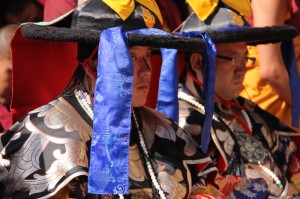 The new supreme head of the Nyingma, Kyabje Taklung Tsetrul Rinpoche is the main holder of the important Northern Treasures cycle of teachings and practices. The Northern Treasures (Changter; Byang gTer) were revealed by Rigdzin Godem and features the prominent sub-cycle, the Konchok Chidu revealed by the terton Jatson Nyingpo and also widely practiced in Kagyu lineages. From mid-May to mid-July His Holiness bestowed these important empowerments to a group of tulkus, khenpos, and ordained and lay sangha at his seat, Dorje Drak monastery in Shimla, India. Khyentse Yangsi was among the participants and on behalf of the Nyingma School he offered a mandala to Taklung Tsetrul Rinpoche in celebration of Rinpoche’s acceptance of this position.
The new supreme head of the Nyingma, Kyabje Taklung Tsetrul Rinpoche is the main holder of the important Northern Treasures cycle of teachings and practices. The Northern Treasures (Changter; Byang gTer) were revealed by Rigdzin Godem and features the prominent sub-cycle, the Konchok Chidu revealed by the terton Jatson Nyingpo and also widely practiced in Kagyu lineages. From mid-May to mid-July His Holiness bestowed these important empowerments to a group of tulkus, khenpos, and ordained and lay sangha at his seat, Dorje Drak monastery in Shimla, India. Khyentse Yangsi was among the participants and on behalf of the Nyingma School he offered a mandala to Taklung Tsetrul Rinpoche in celebration of Rinpoche’s acceptance of this position.
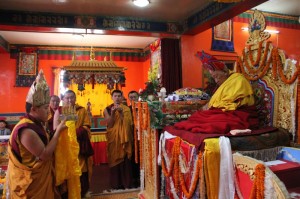 There is a close connection from past lives between Kyabje Taklung Tsetrul Rinpoche, Shechen Rabjam Rinpoche, and Dilgo Khyentse Rinpoche. At the age of 20, in Tibet, Taklung Tsetrul Rinpoche received the Rinchen Terdzo Empowerments from the previous Shechen Rabjam Rinpoche. After leaving Tibet in 1959, HH Taklung Tsetrul Rinpoche received from Dilgo Khyentse Rinpoche transmissions for the collected teachings of Mipham Rinpoche, and empowerments and transmissions for the Heart Essence of Longchenpa, and other Dzogchen practices and tantras. Dilgo Khyentse Rinpoche and Shechen Rabjam Rinpoche also received the Changter and other empowerments from Taklung Tsetrul Rinpoche in Nepal.
There is a close connection from past lives between Kyabje Taklung Tsetrul Rinpoche, Shechen Rabjam Rinpoche, and Dilgo Khyentse Rinpoche. At the age of 20, in Tibet, Taklung Tsetrul Rinpoche received the Rinchen Terdzo Empowerments from the previous Shechen Rabjam Rinpoche. After leaving Tibet in 1959, HH Taklung Tsetrul Rinpoche received from Dilgo Khyentse Rinpoche transmissions for the collected teachings of Mipham Rinpoche, and empowerments and transmissions for the Heart Essence of Longchenpa, and other Dzogchen practices and tantras. Dilgo Khyentse Rinpoche and Shechen Rabjam Rinpoche also received the Changter and other empowerments from Taklung Tsetrul Rinpoche in Nepal.
The empowerments in Shimla are an important milestone as it allows the yangsi of Dilgo Khyentse Rinpoche to receive the Changter from Kyabje Taklung Tsetrul Rinpoche at his own seat in Shimla, Dorje Drak monastery. Rinpoche, in addition to his responsibilities at Shechen Monastery and Nunnery, and his own private retreats, will be traveling in 2012 to give teachings around the world.
News from Shechen Rabjam Rinpoche
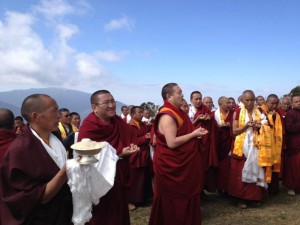 Rinpoche, in addition to his responsibilities at Shechen Monastery and Nunnery, and his own private retreats, will be traveling in 2012 to give teachings around the world.
Rinpoche, in addition to his responsibilities at Shechen Monastery and Nunnery, and his own private retreats, will be traveling in 2012 to give teachings around the world.
May: Croatia In May, Rinpoche bestowed the first of an extensive series of teachings based on Kyabje Dilgo Khyentse Rinpoche’s termas at the Shechen Croatia center. The teachings also included public empowerments and teachings. For further information on this center and the programs held there, see the Shechen Croatia webpage http://www.shechen.hr/english.html
June/July: Bhutan In June, Rinpoche presided over the annual Eight Herukas (Kagye) Drupchen at Bumthang, Bhutan, sponsored by Her Majesty the Royal Grandmother, Kesang Chodron Wangchuk. After this Rinpoche entered into strict personal retreat.
August: Switzerland Upon invitation by the Tibetan community of Switzerland, Shechen Rabjam Rinpoche will serve as representative of the Nyingma School, and preside over 100,000 tsok offerings performed by monks of Namgyal monastery, concluding with a long life empowerment (August 8-12th).
September: Dolpo, Nepal For the last two years, Rinpoche has been giving teachings and empowerments at the request of local Buddhist communities in border regions of Nepal. From August 28th to September 5th, he will visit Dolpo in western Nepal to perform ceremonies, give teachings and bestow empowerments at the Dolpo Sheri Crystal Mountain Festival at the request of the Dolpo Community. Then Rinpoche will also visit other monasteries of that area.
Hong Kong On September 11th Rabjam Rinpoche & Matthieu Ricard will give a public talk on The Importance of the Spiritual Teacher in Tibetan Buddhism. For more information please visit http://www.shechenhk.org or email: shechenhk2012@gmail.com
Singapore Shechen Rabjam Rinpoche & Matthieu Ricard to give a teaching on compassion, Saturday 15th September. For details see: http://dharmainaction.net/
Mexico Teachings from September 19th to 22nd, for more information please write to: dkshechen@me.com.
We will continue to update you with further news about teachings and activities of Dilgo Khyentse Yangsi Rinpoche and Shechen Rabjam Rinpoche through the e-news and on the web and facebook pages.
Graduation and Exam Results
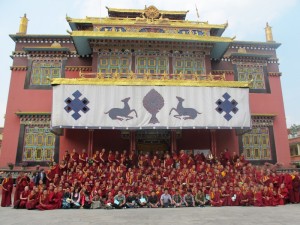 The exam results and graduation ceremonies took place after Tibetan New Year (2139), at the end of March 2012. This year six graduates earned the title of “Khenpo” and one was conferred the title of a Lama, by Shechen Rabjam Rinpoche and Khyentse Yangsi Rinpoche. To earn the title of Khenpo at Shechen Monastery, the student must pass 9 years of Shedra Studies (Philosophical College) and have been assistant teacher (chorpon) in their final 4 years. Upon graduation they become a Lopon. Then they need to teach for a further 5 years before they can be given the title “Khenpo”.
The exam results and graduation ceremonies took place after Tibetan New Year (2139), at the end of March 2012. This year six graduates earned the title of “Khenpo” and one was conferred the title of a Lama, by Shechen Rabjam Rinpoche and Khyentse Yangsi Rinpoche. To earn the title of Khenpo at Shechen Monastery, the student must pass 9 years of Shedra Studies (Philosophical College) and have been assistant teacher (chorpon) in their final 4 years. Upon graduation they become a Lopon. Then they need to teach for a further 5 years before they can be given the title “Khenpo”.
Since the shedra studies were introduced at Shechen in 1988 there have been more than 40 graduate Lopons, and around 20 attaining the title of Khenpo.
Seven Monks enter the 4th Three Year Retreat held at Shechen’s Retreat Center at Namo Buddha
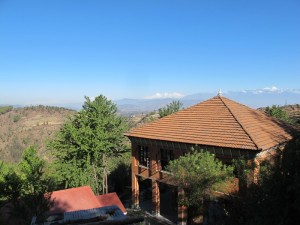 The retreat center of Shechen Tennyi Dargyeling, called Drupde Pema Odseling, is located a few miles from one of the oldest known pilgrimage places in the world, Namo Buddha (in Kavre district, about 40kms from the heart of Kathmandu, to the south-east of the valley). It is a perfect location—a secluded and peaceful hilltop a little higher than Namo Buddha with a view of the Himalayas. The houses are built in the Nepali architectural style. On one side of the land there is a cloister and temple for a small group of monks who are in the traditional three-year retreat.
The retreat center of Shechen Tennyi Dargyeling, called Drupde Pema Odseling, is located a few miles from one of the oldest known pilgrimage places in the world, Namo Buddha (in Kavre district, about 40kms from the heart of Kathmandu, to the south-east of the valley). It is a perfect location—a secluded and peaceful hilltop a little higher than Namo Buddha with a view of the Himalayas. The houses are built in the Nepali architectural style. On one side of the land there is a cloister and temple for a small group of monks who are in the traditional three-year retreat.
This beautiful, peaceful place is of great significance to Buddhist pilgrims, as it is where the thought of Bodhicitta first arose in the mind of the Buddha Shakyamuni in one of his previous lives as a boy called Great Being. It is at this place that the young boy was so moved by compassion at the sight of the suffering of a starving Tigress and the four cubs she was trying to suckle, that he offered her his own body to eat. It is said that in his later life as Shakyamuni Buddha, these five tigers were reborn as his five main disciples.
It is said that the landscape below resembles an eight-petaled lotus, and the sky above has the form of a wheel with nine spokes. As it is said: “In the supreme place of a solitary mountain retreat, any activity is virtuous.” The ancient stupa has become a special place to accumulate merit through activities such as circumambulation and making offerings. People come from all corners of the world to visit the site and make the traditional offerings of butter lamps, a fresh coat of white paint for the stupa, and a pleated cloth that encircles the base of its spire and ripples in the wind.
The ceremony for the commencement of the third traditional three year, three month and three day retreat took place on 11th March 2012. This is when the ‘boundary’ of the retreat is officially sealed and from that time the monks take a vow not to leave the premises, and only those people who are authorized to enter the boundary can do so, the support staff and teachers for the retreat. As one group of monks complete the retreat, another is ready to begin. Seven monks and graduates from the shedra at Shechen Tennyi Dargyeling have joined this current retreat. The resident Retreat Master (Dorje Lopon) is Lama Gyurme Sangyay, who has himself completed 6 years retreat.
The monks in this retreat practice the treasure teachings discovered by Kyabje Dilgo Khyentse Rinpoche. They receive extensive teachings on these practices before and during the retreat from Khyentse Yangsi Rinpoche, Shechen Rabjam Rinpoche, and other teachers. Recently the positive effects of long-term meditation practices and mind training have been studied by neuroscientists. Some of the monks who have completed the retreats are participating in these studies. Dotted around the retreat land are small hermitages for elderly practitioners, and yogis and yoginis who are part of the Shechen community. The center provides an opportunity for the teachings of Dilgo Khyentse Rinpoche to be practiced in-depth.
For more information about this retreat center please visit: https://shechen.org/spiritual-development/retreat-centers/shechen-retreat-center-nepal/
Yarne Summer Rains Retreat
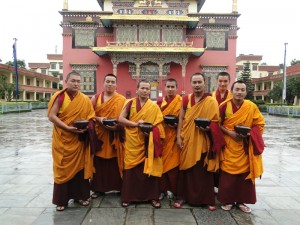 The monks and nuns of Shechen Monasteries and Nunnery all participate in the annual monastic summer rains retreat” (Tib. yarne) which will be held this year from 2nd August to 16th September.
The monks and nuns of Shechen Monasteries and Nunnery all participate in the annual monastic summer rains retreat” (Tib. yarne) which will be held this year from 2nd August to 16th September.
The practice stems from the Indian custom established by the Buddha in the Vinaya Sutra. At that time the retreat was three months long and done during the summer monsoon. The summer retreat in India was a practical response to the monsoon weather. It was also considered not appropriate to travel with the increased likelihood of walking on insects during the rains. At Shechen Monastery the Tibetan version of one and a half months is practiced.
The first day begins with the “Yarne-len” which is the oath-taking ceremony for this retreat (Varsika). During this time none of the monks can leave the monastery grounds and they observe other special vows and restrictions. The regular twice-daily group prayers continue as usual, as well as engaging in specific prayers and meditations for this time. During yarne the monks all eat their morning and evening meals from the traditionally shaped begging bowl in the main temple. Many monks take vows not to eat at night in accordance with this Shravakayana tradition.
The usual Vajrayana practices such as group tsok and other practices that are normally conducted on the 10th, 25th and 29th of the lunar calendar are not practiced during this time.
Contributions can be made through the Shechen website for food and offerings for the Yarne Summer Retreat: https://shechen.org/2012/07/yarne-summer-retreat/
Shechen Ogyen Chozong (Sissinang Nunnery) News from Bhutan!
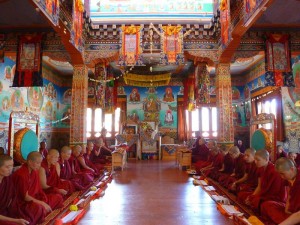 Shechen Orgyen Chozong Nunnery in Bhutan was the first monastic center of Dilgo Khyentse Rinpoche after he left Tibet. Ninety nuns, mainly Bhutanese and ranging in age from 15 to 70 years old, live and study at the nunnery under the guidance of Shechen Rabjam Rinpoche.Four graduate teachers from Shechen’s Philosophical College in Nepal, teach the nuns extensive courses of meditation and study, including reading and writing for the younger girls, and a nine-year shedra (philosophical college) course.
Shechen Orgyen Chozong Nunnery in Bhutan was the first monastic center of Dilgo Khyentse Rinpoche after he left Tibet. Ninety nuns, mainly Bhutanese and ranging in age from 15 to 70 years old, live and study at the nunnery under the guidance of Shechen Rabjam Rinpoche.Four graduate teachers from Shechen’s Philosophical College in Nepal, teach the nuns extensive courses of meditation and study, including reading and writing for the younger girls, and a nine-year shedra (philosophical college) course.
Nuns to install solar systems in Nepal and India As part of Shechen Rabjam Rinpoche’s initiatives towards environmental sustainability, four Shechen nuns have been trained as solar engineers at the Barefoot College in India under the auspices of Karuna-Shechen. In the Fall they will install solar systems in Shechen’s retreat center and in its surrounding villages in Nepal.
Murals in new lhakhang (temple) complete!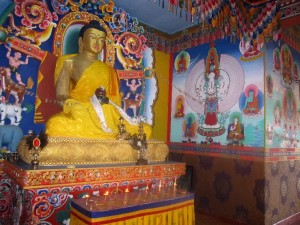 A team of graduate artists from Shechen’s Tsering Art School, under the guidance of its Principal Konchog Lhadrepa, have completed marvelous mural paintings depicting the terma cycle of Dilgo Khyentse Rinpoche. The project was generously supported by the Shelley and Donald Rubin Foundation.
A team of graduate artists from Shechen’s Tsering Art School, under the guidance of its Principal Konchog Lhadrepa, have completed marvelous mural paintings depicting the terma cycle of Dilgo Khyentse Rinpoche. The project was generously supported by the Shelley and Donald Rubin Foundation.
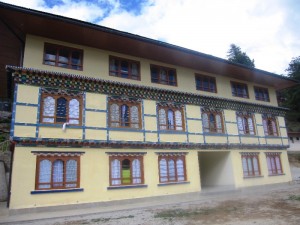 New building for nuns and teachers inaugurated! As the nunnery grew in size and academic reach, more space was needed for classrooms and living quarters. A new building designed to provide housing for nuns and their teachers was inaugurated in May. This move also provides additional classrooms. We wish the nuns well on their studies which, this Fall, will include English classes. The funding for the building came from number of generous donors and also through Magnum Agency’s sale of rare photographs taken by Ani Marilyn Silverstone. Ani Marilyn was a great champion for nuns’ education and advancement throughout her life.
New building for nuns and teachers inaugurated! As the nunnery grew in size and academic reach, more space was needed for classrooms and living quarters. A new building designed to provide housing for nuns and their teachers was inaugurated in May. This move also provides additional classrooms. We wish the nuns well on their studies which, this Fall, will include English classes. The funding for the building came from number of generous donors and also through Magnum Agency’s sale of rare photographs taken by Ani Marilyn Silverstone. Ani Marilyn was a great champion for nuns’ education and advancement throughout her life.
For further information visit: https://shechen.org/spiritual-development/nunneries/shechen-orgyen-chozong-bhutan/ or to sponsor the education and care of a nun.
Coming Soon! Shechen online prayer requests
It is a Buddhist tradition to offer donations to monasteries and nunneries with requests to do specific prayers. These donations help to support the monks and nuns and brings spiritual benefit for the sponsor. Our online prayer request system facilitates these requests. https://shechen.org/prayer-requests/
Meditation and the brain: Neuroscientist Maria Kozhevnikov returns to Shechen Monastery
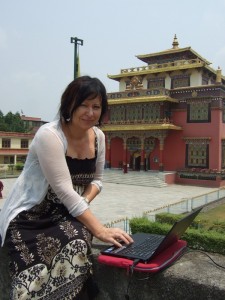 Cognitive Neuroscientist Maria Kozhevnikov PhD, from the “Martinos Center for Biomedical Imaging” at Harvard Medical School, returned to Shechen Monastery in May 2012 to do further research on meditation and its effects on brain function. Previously Maria had conducted experiments on meditators within the monastery in the years 2004, 2005, 2006 and 2008. When asked about her work, Maria explained:
Cognitive Neuroscientist Maria Kozhevnikov PhD, from the “Martinos Center for Biomedical Imaging” at Harvard Medical School, returned to Shechen Monastery in May 2012 to do further research on meditation and its effects on brain function. Previously Maria had conducted experiments on meditators within the monastery in the years 2004, 2005, 2006 and 2008. When asked about her work, Maria explained:
“I am interested in how different types of meditation affect our cognitive and neural functioning. In particular, I am interested in those types of Tibetan meditation that involve visualization, and whether these specific types of meditation can boost our visual-spatial abilities (for example, the ability to retain an image in visual memory for a long time). My previous behavioral research showed that deity meditation practitioners are able to access a heightened state of visual-spatial awareness (the state in which all visual-spatial senses and abilities are dramatically enhanced) immediately after deity meditation session, which last a limited period of time. Interestingly emptiness meditation does not cause a similar effect suggesting that different types of meditation might involve different cognitive capacities.
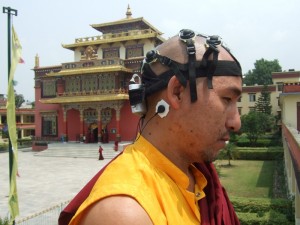 My current research is actually a continuation of my previous research, however this time I am investigating neural correlates of deity and emptiness meditation using 9-channel electroencephalogram (EEG) system. I am interested in examining what different brain areas are involved during these two types of meditation as well as neural correlates of the heightened visual awareness state I observed in my first experiment”.
My current research is actually a continuation of my previous research, however this time I am investigating neural correlates of deity and emptiness meditation using 9-channel electroencephalogram (EEG) system. I am interested in examining what different brain areas are involved during these two types of meditation as well as neural correlates of the heightened visual awareness state I observed in my first experiment”.
Maria herself practices meditation and believes that the results of her research gives proof of direct and positive benefits of meditation on brain function.
“Buddhism and Science Exhibition” to be hosted at Shechen Monastery in November
Shechen Monastery in Nepal is delighted to host a “Buddhism and Science Exhibition” from 7-9th November 2012. The exhibit will highlight the benefits of exploring the interface between science and Buddhism. This event is being organised by representatives from several major monasteries and nunneries under the name of “Monastic Science Leadership”, and is sponsored by the Sagar Family Foundation.
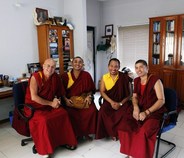 Key speakers include Ven Matthieu Ricard, Geshe Lakdor (Head of LTWA), Geshe Nyima Tashi from Sera Jey, and other notable speakers. They will discuss: the origin of universe/cosmos, evolution of life and its fundamental constituents, brain and mind, and the effects of meditation.
Key speakers include Ven Matthieu Ricard, Geshe Lakdor (Head of LTWA), Geshe Nyima Tashi from Sera Jey, and other notable speakers. They will discuss: the origin of universe/cosmos, evolution of life and its fundamental constituents, brain and mind, and the effects of meditation.
Participants will come from ten major monasteries in South India, including Sera, Dripung and Ganden Monasteries, three monasteries and nunneries from Dharmsala, and Mindroling Monastery in Northern India. It is a great honor for Shechen to host this innovative workshop, the first of its kind in Nepal.
Khenpo Karma Tsultrim and Lopon Tashi go to teach in Mexico
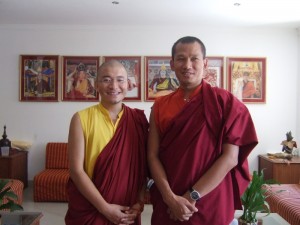 Lopon Tashi and Khenpo Karma Tsultrim traveled to Mexico in May to be resident teachers for the Sangha at Shechen’s two Mexican centers. Khenpo Karma Tsultrim graduated from the Shedra (Philosophical College) at Shechen Monastery in 2003. He taught at the college for several years until he became the resident teacher for three years at Sissinang Nunnery in Bhutan and at Shechen Bodhgaya for four years. He traveled and taught in England and Europe for in 2002.
Lopon Tashi and Khenpo Karma Tsultrim traveled to Mexico in May to be resident teachers for the Sangha at Shechen’s two Mexican centers. Khenpo Karma Tsultrim graduated from the Shedra (Philosophical College) at Shechen Monastery in 2003. He taught at the college for several years until he became the resident teacher for three years at Sissinang Nunnery in Bhutan and at Shechen Bodhgaya for four years. He traveled and taught in England and Europe for in 2002.
Lopon Tashi graduated from the Shedra in 2010. After graduation he taught in Mustang province and in Pokhara, Nepal. He was one of the initiators of the Shechen Eco Group and was also involved with the activities of Sacred Earth Trust in Bodhgaya. He worked with a student exchange group from the Netherlands called Global Exploration and has been visiting different high schools in the Europe since 2009, teaching Dharma and bringing Buddhist values and ideals to young students in Europe.
Shechen Mexico’s centers are located in Guadalajara and Mexico City. The teaching program will offer fundamental Buddhist teachings, such as the Four Noble Truths, Nagarjuna’s “Letter to a Friend”, the “37 Practices of a Bodhisattva” and so on. Lopon Tashi and Khenpo Karma Tsultrim will also be teaching Dharma to children and learning Spanish while they are in Mexico.
Shechen Monastery wishes them all the best in their new station, working for the benefit of beings through the teachings of the precious Buddha-Dharma!
For further information on activity of Shechen Mexico please write to: dkshechen@me.com
Tsering Art School News
Thangka Exhibition
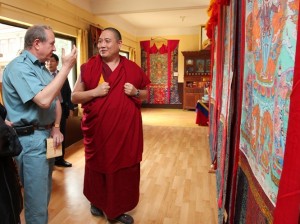 The second exhibition of thangkas by the Tsering Art School was held from March 31st until April 4th. The purpose of the exhibition was to profile the work from the school and to add to the public’s appreciation for the Buddhist art of thangka painting.
The second exhibition of thangkas by the Tsering Art School was held from March 31st until April 4th. The purpose of the exhibition was to profile the work from the school and to add to the public’s appreciation for the Buddhist art of thangka painting.
The exhibition was enthusiastically received by a steady flow of visitors who expressed a great sense of inspiration and appreciation for the work being shown. The exhibition opened with addresses by Shechen Rabjam Rinpoche, the principal Konchog Lhadrepa, and Charlotte Davis, a graduate and staff member. Among the attendees were the Russian Ambassador and his wife and the French Ambassador. They expressed their appreciation for the opportunity to see these wonderful works of traditional Buddhist art and to gain some sense of the spiritual life of thangka painters.
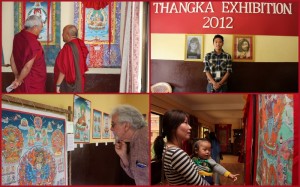 Helping the organization of the exhibition was Toni Sanders, a student at the school from Australia who has a degree in Fine Arts from the Australian National University. The art school manager, Lhadre Lopon Tenzin Oser and secretary Lobsang Dolma along with other staff and students, all worked tirelessly to prepare everything for this event.
Helping the organization of the exhibition was Toni Sanders, a student at the school from Australia who has a degree in Fine Arts from the Australian National University. The art school manager, Lhadre Lopon Tenzin Oser and secretary Lobsang Dolma along with other staff and students, all worked tirelessly to prepare everything for this event.
The exhibition profiled works from the students and graduates, the Principal, Konchog Lhadrepa and his team of graduate artists, who are currently painting a series of major thangkas for Shechen Monastery at the newly consecrated Rabsel Thangka Studio. The works displayed were of a high quality and beauty rarely found today.
New Art School Curriculum: 9 years Lhadre Lopon Degree At the Shechen Monastery annual meeting, a new course of study was designed for our art school students. In order to improve the curriculum of the school, especially for those wanting to teach, Shechen monks who study at the school will now study for an additional three years at the Shechen Philosophical College (Shedra) after completing the six-year art school course. This option is also open to other Tsering Art School graduates. In future, the title “Lhadre Lopon” will only be awarded to students who have completed nine years of study.
Rabsel Thangka Studio Report The Rabsel Thangka Studio artists are painting a series of large, detailed thangkas for the monastery based on the termas of Dilgo Khyentse Rinpoche. The artists have also started to accept outside commissions. To place a commission for a thangka please write to Lobsang Dolma or visit on tsering.school@shechen.org or visit www.tseringschool.org
News from Shechen Eco Group!
 The Shechen Eco Group has been very active since its formation in December 2011. The main activity has been to improve the awareness and action within the monastery utilizing principles of “Zero Waste” by implement the “Four R’s” (Refuse, Reduce, Re-use and Recycle). In terms of tackling the widespread problem of dumping of non-biodegradable waste in the streets, the eco-group participated in a number of street cleanups in the local Boudhanath area in January and February. During the April-May holiday period, the group continued weekly cleanups within the monastery and worked with the monastery gardeners. An area where garbage had been dumped is being transformed into a garden. The younger monks as well as the Eco Group leaders from the various departments of the monastery have been very enthusiastically involved in this activity. The Eco Group also started a Facebook page to keep people informed about the group’s activity and progress, called “Shechen Eco Group”.
The Shechen Eco Group has been very active since its formation in December 2011. The main activity has been to improve the awareness and action within the monastery utilizing principles of “Zero Waste” by implement the “Four R’s” (Refuse, Reduce, Re-use and Recycle). In terms of tackling the widespread problem of dumping of non-biodegradable waste in the streets, the eco-group participated in a number of street cleanups in the local Boudhanath area in January and February. During the April-May holiday period, the group continued weekly cleanups within the monastery and worked with the monastery gardeners. An area where garbage had been dumped is being transformed into a garden. The younger monks as well as the Eco Group leaders from the various departments of the monastery have been very enthusiastically involved in this activity. The Eco Group also started a Facebook page to keep people informed about the group’s activity and progress, called “Shechen Eco Group”.
Fiberglass bins to separate the garbage from the recyclable material within the monastery were delivered and the local Women’s Environment Preservation Committee (WEPCO) came to train the eco leaders in garbage separation and help us find various local “kabadi” (recycling operators) to remove the material for recycling and re-use. This recycling program is successfully underway. The monastery has also stopped distributing disposable plastic cups and plates when visitors come to join ceremonies and no longer purchase feast offerings (tsog) that have plastic packaging.
The eco-group coordinator, Charlotte Davis, met with Lillian Sum, the Founder and Director of Sacred Earth Trust, an environmental group that does marvelous work in cleaning-up the Bodhgaya area. Lillian advised us on a number of things to do with gardening principles, how to recycle plastic and also offered her skills as a qualified environmental architect to draw up a plan for a future renovation project at the front of the monastery based on environmental design principles.
To keep up to date with our regular weekly activity join us on Facebook, or keep posted through our updates in the Shechen e-newsletter and website! https://shechen.org/about/eco-group/
Elementary School Expansion!
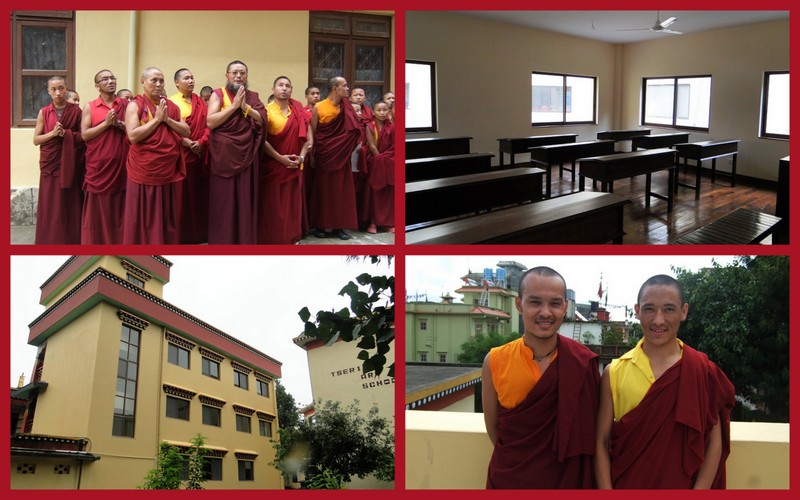 In the last two years enrollment for boys under fourteen years old at Shechen Monastery in Nepal has increased and there are now ninety young monks under the monastery’s care. Dorm rooms had to be also used for classes and there was no room for a library or a peaceful place for study.
In the last two years enrollment for boys under fourteen years old at Shechen Monastery in Nepal has increased and there are now ninety young monks under the monastery’s care. Dorm rooms had to be also used for classes and there was no room for a library or a peaceful place for study.
Thanks to the generosity of an anonymous donor, a new building graces the monastery compound in Nepal. It has seven elementary school classrooms and a large workshop room for torma making and other plastic arts. The original hostel is now being refurnished and will be used only for housing. The young monks and their teachers are delighted with the new situation that allows for more structure and cleanliness.
If you are interested in donating towards other special projects, please view our “wish list” on: https://shechen.org/donate/wish-list/
Celebrating 25 Years of Sponsorship
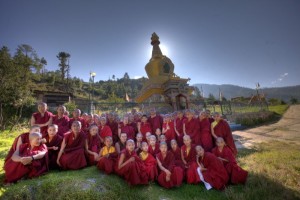 Shechen’s sponsorship program was initiated in 1987 to help the monastery support the more than 500 monks and nuns completely under its care. The funds supplement the costs of medical expenses, pocket money, robes, educational supplies, and the yearly food budget. The monks and nuns are our “Shechen Ambassadors” and write an annual letter to their sponsor.
Shechen’s sponsorship program was initiated in 1987 to help the monastery support the more than 500 monks and nuns completely under its care. The funds supplement the costs of medical expenses, pocket money, robes, educational supplies, and the yearly food budget. The monks and nuns are our “Shechen Ambassadors” and write an annual letter to their sponsor.
The program has been essential for the monastery and our sponsors seem to enjoy the experience. We are deeply appreciative of this support. Currently we have only 200 sponsors, and we are hoping to add another one hundred during this anniversary year.
Please consider joining the Shechen “family” by becoming a sponsor and telling a friend, or giving a sponsorship as a gift. Your annual $250 donation makes a great difference to an individual and creates a vital link to a pure wisdom tradition. Thank you.
How you can help
For further information on how you can support the activities of Shechen’s special projects, to sponsor a monk or nun, or help fulfill the “wish list” go to: https://shechen.org/donate/
